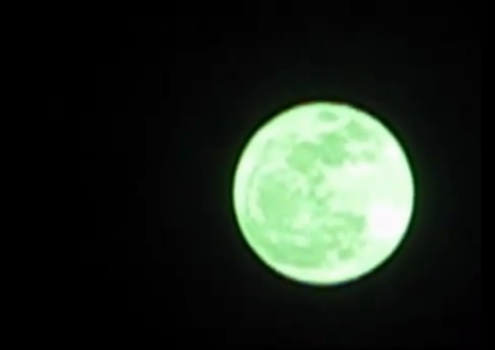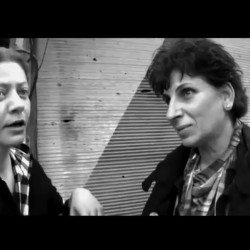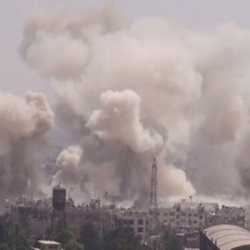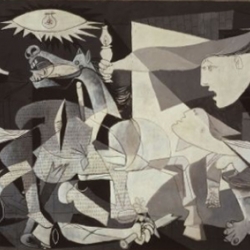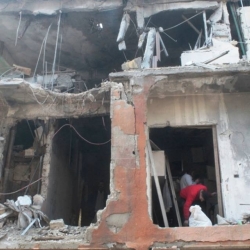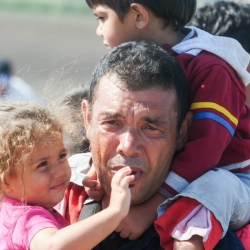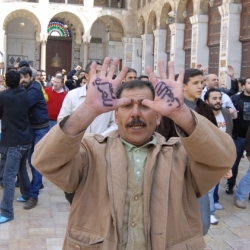Between Life and Death. Liminal Images from the Syrian Revolt
30/01/2018
Author: Cécile Boëx, Instructor at the School for Advanced Studies in the Social Sciences(EHESS)
Translation by Stefan Tarnowski
During my five years of research on the uses and grammars of video in the context of revolt then war in Syria, many images have touched me, overwhelmed me. Others have shocked me, wounded me. And yet out of this visual, aural and emotional accumulation, three videos stand out. They permeate my memory and my thought. Each inscribed in its own way in a grey, intermediate zone, where vision is blurred and the modes of perception are redefined. In this precarious place, it is difficult to draw the boundary between an intentional filmic gesture, marked above all by the desire to testify; and non-mastery, linked to the contingency of the event, or rather, to its embodied experience. Liminal images, signifying the paradoxical uniqueness of these videos, where points of contact flourish randomly between subjective experience and history-in-the-making, between body and event, life and death. Because these videos are filmed by image-makers at their own great risk, whether ordinary folk or media activists who have become specialised in filming events out of necessity.
Since March 2011, the need to film demonstrations and their repression has emerged from a will to reinstate the truth of the facts, denied in the official narrative, which claims that there’s a conspiracy by the protesters who are described as Islamist terrorists. Video has been put to an array of uses (tributes, announcements, novel practices for filming protest, fighting etc.) as the revolt has evolved and gradually descended into outright war. Since then, hundreds of thousands of videos have been uploaded, principally on YouTube. Never in history has a revolt and a conflict been so well documented by those directly involved in events. Paradoxically, this proliferation of often anonymous images and sounds doesn’t amount to a form of hyper-visibility: on the contrary, the accumulated effect becomes an obstacle to visibility. Disseminated in the shifting algorithmic space of the Internet, these images that call out to us are for the most part in a state of latency—that is when they don’t just disappear pure and simple.[1] Buried beneath strata of other images and sounds, they must be patiently sought out, one by one.[2] So, despite their apparent accessibility, these videos are in fact rare. Most are also ineffective. First of all, because they give little hint of the context in which they are filmed, usually an emergency. And then despite how numerous they are, they haven’t had any real effect on the balance of power. Their value and power are located beyond the volatile temporality of politics and the media. At the core of the intensity and uncertainty of lived experience, which operates within a double movement that both dilates and contracts the revolt’s own time and history. This contradictory coalescence of temporalities brings out unprecedented regimes of visibility, often at the limits of our habits of perception.
Watching and listening to these videos requires a sort of stubbornness and humility. It reveals the poverty of theory, which would otherwise crush them, format them, and attenuate just how singular and radical these videos are. The uses of video in Syria are so varied and so marked by the evolution of events that it would doubtlessly be vain to seek out the principles of their uniqueness. But other paths of understanding are open for exploration. The videos that I bring to the surface here are in no way representative of the vast multitude. But they are all affected by lived experience: they are inseparable from the moment in which they are filmed and those who film them, because they are one with them. The image-maker documents the event and at the same time is caught up in it. These images are embodied, alive, which propel us brutally into the thick of the action and the instant. They are driven by the desire to show in order to bear witness, however the intensity of the filmed situation renders them opaque. Thus, they are paradoxical images, apparent failures, counterproductive, illegible, contrary to their original intention. The following three videos were filmed between 2011 and 2012, before the militarization of the revolt. They still convey a sort of innocence, a spontaneity which later becomes harder to find, when concerns over effectiveness leads to a standardization. During this period, on the other hand, there are instinctive practices of filming that give rise to unprecedented audio-visual forms. In each of these videos words, sounds, emotions and gestures are described, contextualized and questioned. For each of them, I try to grasp the passage between the subjective and the collective, and the possibilities of an encounter between the person filming and the person viewing.
Demonstration, Hama, 25 March 2011, anonymous, 1’16”[3]
Ten days after the bloody repression of the first demonstrations in Deraa, the residents of Hama decided to take to the streets and show their solidarity with the victims.[4] During this spontaneous protest, we hear demonstrators shouting “Freedom”, “Peaceful”, and “With our soul, with our blood, we sacrifice ourselves for you, Deraa!” Uttering these words in the streets of Hama has particularly important resonances given the city’s history. In 1982, during the reign of Assad the father, the city was bombarded for several weeks as the regime crushed an opposition movement that united diverse segments of society, including both secularists and Islamists. But the choice to bombard Hama, stronghold of the Islamist opposition, allowed the regime to ascribe its brutal repression to the “war against Islamism”, a pretext that continues to be deployed during the current conflict. The massacre, committed with complete impunity, killed more than 30,000 people, not counting the number of missing and displaced persons. It took place behind closed doors: no cameras. Still to this day, only a dozen photographs of the destroyed city and the rows of corpses have surfaced. In 2011, Hama’s protestors knew the full extent of the barbarism the regime was capable of. But they also thought, unfortunately naively, that by filming they could protect themselves and restrain the violence of repression by submitting it to an external gaze.
Raw footage from the thick of the event, the clip is filmed by a mobile phone held at arm’s length. Erratic movement suggests a stream of men protesting spontaneously: no placards or posters, the slogans shouted rowdily, the sound of horns blaring. A few men turn back nervously. We can make out buildings, palm trees. But in the end, very few contextual elements make it immediately possible to understand what is involved. With little informational value, this filmed fragment gives only an incomplete account of the event. Its documentary value lies elsewhere—precisely in its illegibility. The chaos of images and sounds makes it possible to see and feel the emotions of the image-maker and those around him in an immediate physical way. The dislocation and interpenetration between frames, ruptures in the visual field, account for the precarious status of this illicitly taken video. Here, the act of filming is also an event in itself that testifies to this moment of rupture where what was not previously conceivable has become just that. This radical change, a moment of no return, true to the revolutionary moment, condenses conflicting emotions. The feverish excitement of the images and the intensity of the protestors’ voices testifies in a very concrete way to this state of confusion, melding euphoria with fear and uncertainty. And in particular we hear the voice of the image-maker. History in the making is mixed with a distinctive tone of a voice, a shout rather. Revolt—not merely political or historical—is also profoundly intimate for every individual who participates.
It’s this intimacy that the video raises. It documents this extreme experience of protest in an ultra-repressive context and produces a kinetic and emotional vision of the event, too radical to be represented coherently. The articulation between body, camera and event shifts visual perception to sensory perception. To be thrown abruptly into a fragment of such an intense experience is troubling. One is engulfed, overwhelmed, disoriented, just like the person filming. There are others like this one—tens of thousands were taken during the protests in Syria, as well as in Tunisia, Egypt, Libya, Yemen and Bahrain in 2010 and 2011—but something deeply affecting is happening here. One moment (55”) the image-maker is so engulfed in the experience he’s living that he forgets he’s filming. We see the frame follow the rhythm of the arm swaying to the slogan’s cadence.[5] The gesture of filming dissolving into the gesture of protest takes place gradually, swelling like a wave. At the beginning of the video, it’s hesitant: anxious glances attempt to make out who in the crowd might belong to the secret police, false starts as numerous slogans are shouted simultaneously. Then the protest marches forward and the voices find a shared rhythm; the collective takes shape. The person filming has without a doubt never protested before and his apprenticeship unfolds before our eyes. At first, the movements are timid but a few seconds later he starts to assert himself. We witness the emergence of a protesting body both in the singular and in the plural. At this moment, the image reverses our gaze, literally. It liberates itself and changes status, carried along by reality. Like a seismograph, it records the tremors of the event, the extraordinary energy of a crowd that is part of a revolt, that defies death. The image conceived in a moment of paroxysm—both embodied and mechanical—is like a live imprint of this relation between the historical event and the interior event, between the collective and the intimate.
Moon, Hama, 6 April 2012, Anonymous, 31”[6]
During my many wanderings on YouTube, I came across an unexpected video, one unlike any other. So much so that when downloading it, I didn’t bother to note down its URL, nor its online title, essential information for cross-referencing the videos in my personal collection. I found it wonderful, but it was so singular that I did not see how it could fit into the categories I was beginning to draw up. I simply noted that it was shot in the region of Hama. The only information available about it is exactly what can be seen and heard in the video: the full moon, and the exchanges of gunfire on 6 April 2012. With these few clues, I tried in vain to find it again on YouTube. However, I did find a dozen videos documenting the same event, which allowed me to put together some context. In the Bab al-Qabli neighbourhood, a demonstration had taken place that afternoon ending in numerous arrests. That night, exchanges of gunfire can be heard. But how is it possible to show what cannot be seen? How to film without putting yourself in danger? Some videos frame the minaret lit by the green neon light of a mosque, or the city lights in the distance. But no-one films the moon, which is full that day. This is a truly unique gesture by the image-maker. The choice of shot is also accompanied by the gesture of editing: the video is composed of four shots of very unequal duration. The first lasts 20 seconds, the other three only a few seconds, probably taken a few minutes, if not a few seconds, apart. How can this montage be explained? It doesn’t correspond to the widespread codes of the filmed testimony during the period this videoclip is taken, the main feature of which is the single take, the sequence shot, in order to avoid any suspicion of manipulation.
This video is an enigma that triggers a cascade of questions and that activates the imagination. Like the previous clip, it’s contradictory in the sense that it doesn’t show what it’s supposed to document. Yet the intention to provide a testimony is beyond doubt. Not once but twice, because of the editing effect, the image-maker specifies the date of the recording. But the sounds of the exchanges of gunfire, although quite clear and near the beginning of the take, are entirely supplanted by the hypnotic, almost unreal image of the huge fluorescent moon that jolts, as if wanting to escape the frame. The involuntary inversion of the video’s subject matter says, it seems to me, something of the fragility of this type of testimony, the impossibility of representing the event itself, either because of being within it, as in the first video; or because the event itself is a threat that must be filmed from a distance, as in this video. In either case, one loses sight of it. Here, the gesture partly escapes the person filming, engulfed by experience. His hand trembles and the zoom accentuates his trembling, reverberating on the moon, like a trance. These uncontrolled movements doubtlessly explain the editing, as the image-maker sought to keep the moon in frame. This even seems to become his main concern, an obsession even. It’s as if he’s clinging to the orb. The sky, when everything is uncertain, when war approaches or is unleashed, the sky is the only thing that remains immutable, that remains indifferent to gunshots and tragedy. This moon certainly has something reassuring for the person filming, like a beacon, a primordial image. That's why it’s so important to him that it stays in frame. An accidental metaphor for anguish, the video becomes a filmic incantation to escape the chaos.
The video is much more than a form of involuntary poetry: it is experience itself, a fragment of existence that takes place in and through the image. Here, body and emotions are both very present in the lens’s uncontrolled movements and in the voice. The person filming speaks too fast and whispers, because he’s filming surreptitiously. Although anonymous, the video is embodied, and the viewer is propelled into the other’s space. This immediate, close relationship is all the more striking because it’s fleeting. It grants the possibility of being and seeing with. One begins to want to know more about the person filming, to imagine the features, to worry about what has become of him…This 31-second-long video produces an encounter. In that sense, it’s the polar opposite of the disembodied, controlled, ultra-legible media images, which, when it comes to Syria, thrust the other into the status of victim.[7] In the same way some of the Islamic State’s videos, especially the most spectacular, are a hyperbolic variety of those media images. Technical mastery and morbid fixity of framing serve an inflated vision of reality and horror. Unlike traditional media images, the Islamic State deletes its victims physically and forces us to look at the execution down to the smallest detail as the spectacle of its supposed glory. This is consumable barbarism, and so as to keep our attention, the scriptwriters of death deploy an arsenal of staging, special effects, and props. Each execution video thus becomes an event invested in producing an ever more intense effect of stupefaction, with the assurance that it will be relayed by the media, for whom stupor and fright are of guaranteed value. In return, media images are re-used in some ISIS videos.[8]
In still or moving images that illustrate the different dimensions of the conflict in Syria, we do not kill victims. But we show their bodies as lifeless, even (or especially) those of children. Photos are re-framed, and at times colour-graded, to emphasise a detail, as if aesthetics can mitigate the inconceivable. This only accentuates the abject. Why don’t we know the faces of the victims of the Idlib chemical massacre or of Aylan Kurdi when they were alive, like we do those of the victims of the Paris or Nice bombings? Whoever filmed this moon on 6 April 2012 not far from Hama is no victim. He is a man who speaks and shares a fragment of his existence in a way that is unique to him. He is a subject with agency, not an object of compassion. He shows a full moon for all of us to see, self-evident. Evidence of repression and the almost caricatural asymmetry of power. Evidence of filming, in order to reclaim the means of saying and showing the real, long confiscated. Revolt lies in these surreptitious and potentially deadly gestures.
Since discovering this video, I watch or refer to it regularly. It has become part of me. At times I’ve felt the need watch it again to cleanse my gaze of images that I should never have seen. Like a talisman, it gives me the strength to look at all the others. I cling to this image like the man who filmed it clung to the moon. And this image binds us.
Mu’awiya Ayyub, Rastan, 28 January 2012, 2’45”[9]
On 28 January 2012, Mu’awiya Ayyub, a media activist from Rastan’s Local Coordinating Committee (near Homs),[10] was filming, according to the title of the video uploaded online, when soldiers from the regime army began shooting at civilians. He’s in a street not far from the gunfire. At the beginning of the video, we hear a precise description of the scene: “Gunshots today, 28 January 2012, fired at a few protesters near Sheikh Mustafa al-Hamid’s house.” At that precise moment, he’s hit. The camera quivers, he collapses and we hear a groan. Amid a flash of light and the chaos of his collapse we see what seems to be the silhouette of the person filming (0’16”). The frame falls still. It’s obstructed, no doubt by his hand, and ghostly spots undulate in front of the lens. For a few seconds, we hear only shots being fired. Then they’re mixed with the sounds men (local residents? fellow activists?) shouting “God is the great!” Even in war, the fatal blow provokes the same astonishment. Then the image’s frame moves briefly: someone approaches and asks for help. The gunshots intensify. He retreats and takes cover. We hear someone else ask, several times: “Who is it?”. Another laments “My God!”. And someone says: “Rest in peace.” The sounds of gunfire do not succeed in blocking out the voices. For almost a minute and a half after the death of the activist, the camera continues to record, the mechanical eye acting as substitute for the human eye. It takes a certain amount of time for the viewer to realise the extent of the brutality of this passage, of the radical break between before and after irrupting into life and the image. In the first part, we see nothing of what was supposed to be documented. We only hear the sound of gunshots. And then death strikes, exposing the vulnerability of the person filming.
Ever since Patricio Guzman’s The Battle of Chile (1975), the death of a cameraman recorded live has become a motif of journalistic heroism.[11] But for it to be dubbed as such, it is still necessary, at the very least, to see the person aiming and shooting. There’s no such dramaturgy here; just a before and after, death in all its shocking trivialness. No spectacle, but rather a raw fragment of experience, an ordeal by images. This death we do not see; it’s as if it were imprinted on the image, like a negative, a loan. It modifies the frame, colour and texture. The proximity of the person who just lost his life, the enigmatic movements within the frame and the sound of the wind blowing create a strange effect of presence. There’s the impression of being between two worlds. The world of the dead and of the living, whose voices and shots can be heard within an image without field but still infused with reality. A liminal image, simultaneously the trace of life and of death. If this video suggests that violence could be portrayed without seeing murdered bodies, it beckons the viewer nonetheless. Why upload a video like this? Why not cut it right after the image-maker’s death at 16 seconds? It must be to pay homage to Mu’awiya Ayyub by showing these very moments, by keeping track of it somewhere in the virtual world. It must be, thanks to the thread of continuity between life and death made possible by the camera, to inscribe his act within a sort of autonomy and durability that will survive even the snipers and the repression.
Whoever looks is thus invited to experience and to remember. This reception of utterance, sound and image can hardly be done alone. It calls for other images, other gazes and other words to grasp the full extent of these filmic gestures rooted in the intensity of the experience of those struggling with history and violence. The absence of mediation requires the arduous, often painful, labour of reading, in which emotion and reflection must be mutually reinforcing. This is where the understanding but also the relaying of these images plays out. Extremely localized both in time and in space, almost intimate, these videos are inseparable from their contexts. Yet they also touch on something fundamentally universal: revolt and its bundle of contradictory feelings and experiences exultaion, fear, hope, uncertainty, and death. Fragments of a tiny and fragile living memory, which shake the well-structured accounts and scenarios that would make us forget the meaning of the revolt in Syria and elsewhere.
[1] To date, about 15% of the videos in my corpus have been deleted, either because the accounts used to upload them were closed, or they were removed by YouTube’s administrators.
[2] 95% of videos filmed in Syria are untranslated and only labelled in Arabic.
[3] Archived and viewable on my Vimeo page https://vimeo.com/197280320 and on YouTube https://www.youtube.com/watch?v=ywviRWqZE7U, posted on March 25, 2011 by SyrianFreePress (17627 views on April 7 2017).
[4] Mobilisations followed a iterative logic, with repression and death intensifying the protests. Thus, by the end of March 2011, demonstrations in Damascus, Homs, Hama, Tartous, Lattakieh were organised in support of Der'a.
[5] A four-second fragment of this video is included in the first section of Oussama Mohammad's Silvered Water (2014). It must be this same gesture and the slogan which accompanies it (“By our soul, by our blood, we sacrifice ourselves for you, Deraa”) that caught the attention of the director, and which he places alongside other filmed fragments of demonstrations. Nevertheless, removed from its own temporality, the 4 seconds extract is only illustrative of the scenario imposed by the director
[6] Archived and viewable from this link https://vimeo.com/197281756.
[7] The anonymous collective of Syrian filmmakers Abounaddara produces a reflection on the notion of the right to the image in the context of the conflict in Syria. See for example the article "We are dying, take care of the right to the image", published in Libération, 1 May 2016
http://www.liberation.fr/debats/2016/05/01/nousmourons-prenez-soin-du-droit-a-l-image_1449830
[8] Cf. Cécile Boëx, « La vidéo posthume d’Amedy Coulibaly. Le martyre à portée d’images », Cahiers du cinéma , n. 708, February 2015.
[9] https://vimeo.com/212740186 and https://www.youtube.com/watch?v=I63UupYDofw&t=26s, posted online in 2012 by NAZEM ALMANSOUR (1083 views as of 13 April 2017).
[10] A network of coordinating committees was rapidly set up to organise demonstrations, take care of the wounded in secret hospitals, and ensure the documentation and dissemination of the demonstrations.
[11] At the end of Part 1, The Insurrection of the Bourgeoisie, Guzman reuses images shot by the reporter Leonardo Henrischesen, himself shot by a soldier while filming a clash between demonstrators and the police.



